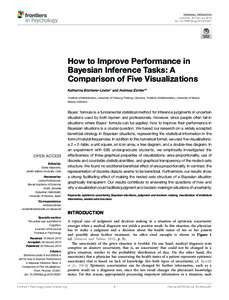Aufsatz

How to Improve Performance in Bayesian Inference Tasks: A Comparison of Five Visualizations
Zusammenfassung
Bayes’ formula is a fundamental statistical method for inference judgments in uncertain situations used by both laymen and professionals. However, since people often fail in situations where Bayes’ formula can be applied, how to improve their performance in Bayesian situations is a crucial question. We based our research on a widely accepted beneficial strategy in Bayesian situations, representing the statistical information in the form of natural frequencies. In addition to this numerical format, we used five visualizations: a 2 × 2-table, a unit square, an icon array, a tree diagram, and a double-tree diagram. In an experiment with 688 undergraduate students, we empirically investigated the effectiveness of three graphical properties of visualizations: area-proportionality, use of discrete and countable statistical entities, and graphical transparency of the nested-sets structure. We found no additional beneficial effect of area proportionality. In contrast, the representation of discrete objects seems to be beneficial. Furthermore, our results show a strong facilitating effect of making the nested-sets structure of a Bayesian situation graphically transparent. Our results contribute to answering the questions of how and why a visualization could facilitate judgment and decision making in situations of uncertainty.
Zitierform
In: Frontiers in psychology 10 (2019-02-20) , S. 267 ; ISSN: 1664-1078Förderhinweis
Gefördert durch den Publikationsfonds der Universität KasselZitieren
@article{doi:10.17170/kobra-20190521501,
author={Böcherer-Linder, Katharina and Eichler, Andreas},
title={How to Improve Performance in Bayesian Inference Tasks: A Comparison of Five Visualizations},
journal={Frontiers in psychology},
year={2019}
}
0500 Oax 0501 Text $btxt$2rdacontent 0502 Computermedien $bc$2rdacarrier 1100 2019$n2019 1500 1/eng 2050 ##0##http://hdl.handle.net/123456789/11238 3000 Böcherer-Linder, Katharina 3010 Eichler, Andreas 4000 How to Improve Performance in Bayesian Inference Tasks: A Comparison of Five Visualizations / Böcherer-Linder, Katharina 4030 4060 Online-Ressource 4085 ##0##=u http://nbn-resolving.de/http://hdl.handle.net/123456789/11238=x R 4204 \$dAufsatz 4170 7136 ##0##http://hdl.handle.net/123456789/11238
<resource xsi:schemaLocation="http://datacite.org/schema/kernel-2.2 http://schema.datacite.org/meta/kernel-2.2/metadata.xsd"> 2019-05-21T12:18:35Z 2019-05-21T12:18:35Z 2019-02-20 doi:10.17170/kobra-20190521501 http://hdl.handle.net/123456789/11238 Gefördert durch den Publikationsfonds der Universität Kassel eng Urheberrechtlich geschützt https://rightsstatements.org/page/InC/1.0/ epistemic uncertainty Bayesian situations judgment and decision making visualization of statistical information nested-sets structure 510 How to Improve Performance in Bayesian Inference Tasks: A Comparison of Five Visualizations Aufsatz Bayes’ formula is a fundamental statistical method for inference judgments in uncertain situations used by both laymen and professionals. However, since people often fail in situations where Bayes’ formula can be applied, how to improve their performance in Bayesian situations is a crucial question. We based our research on a widely accepted beneficial strategy in Bayesian situations, representing the statistical information in the form of natural frequencies. In addition to this numerical format, we used five visualizations: a 2 × 2-table, a unit square, an icon array, a tree diagram, and a double-tree diagram. In an experiment with 688 undergraduate students, we empirically investigated the effectiveness of three graphical properties of visualizations: area-proportionality, use of discrete and countable statistical entities, and graphical transparency of the nested-sets structure. We found no additional beneficial effect of area proportionality. In contrast, the representation of discrete objects seems to be beneficial. Furthermore, our results show a strong facilitating effect of making the nested-sets structure of a Bayesian situation graphically transparent. Our results contribute to answering the questions of how and why a visualization could facilitate judgment and decision making in situations of uncertainty. open access Böcherer-Linder, Katharina Eichler, Andreas doi:10.3389/fpsyg.2019.00267 publishedVersion ISSN: 1664-1078 Frontiers in psychology 267 10 </resource>
Die folgenden Lizenzbestimmungen sind mit dieser Ressource verbunden:
Urheberrechtlich geschützt

